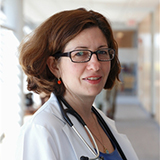In early May 2020, six weeks after the novel coronavirus had made its way to Boston, I was preparing for my first shift at Boston Medical Center’s “influenza-like illness” (ILI) clinic. The purpose of the clinic was to unburden our emergency department of the less severely ill patients whose symptoms were suggestive of covid-19. As a primary care doctor for adults and a health disparities researcher, I had spent the past few weeks conducting medical visits by telephone, following my patients’ hospital courses from the emergency department through the ICU and in most cases, back to their homes. I was also helping to homeschool my daughters, age 12 and 14. My husband, a writer and Russian literature professor, was teaching our daughters Anna Karenina. Without a daily commute and with a hiatus in some of my research, I had time to join the class. One Tolstoyan sentence, early in the novel, struck me: “There was no answer, except the general answer life gives to all the most complex and insoluble questions. That answer is: one must live for the needs of the day…” I lived for the needs of the day by supporting my family: food shopping, cooking, cleaning, walking our poodle; and caring for my patients—from a distance.
During semiweekly video meetings, our primary care leaders encouraged us to “step up” and volunteer to help care for infected patients. A combination of duty and guilt prompted me to sign up for additional on-call sessions and eventually, the ILI clinic. The Sunday evening before my first shift, the medical director sent a detailed e-mail outlining the clinic workflow and testing guidelines. Her e-mail concluded with an invitation to call her cell phone “liberally.” Anxiety overcoming me, I called her with a list of questions. Was I at risk for bringing the infection home to my family? From what the medical director shared with me, each anxious medical provider was anxious in her own way. One colleague, for example, was staying in a nearby hotel, apart from her family, while working in the clinic.
Earlier in my medical career, I had fearlessly—and perhaps injudiciously—worked in settings where I had significant exposures to infectious pathogens. As a medical student, I had taken a year off to study the epidemiology of multiple drug-resistant tuberculosis in the favelas of Northeastern Brazil. Dressed in all white, but without a mask, I had interviewed families with tuberculosis in their poorly ventilated homes. As a senior resident, I had scrubbed in on caesarean sections with HIV-infected women in South Africa. Learning that the virus had not yet infected a single health care worker in the ILI clinic, my fears about contracting covid-19 dissipated.
I received an e-mail the morning of my first ILI shift from a former colleague, an infectious diseases physician in Brazil with whom I have been in sporadic contact over the years. He asked me if I was OK, and attached an educational video he had made, in Portuguese, about the importance of wearing masks. I took his e-mail to be a sign—a sign that all of us physicians around the globe were in this pandemic together, and that volunteering for the ILI clinic was the right thing for me to do.
Evaluating patients in the ILI clinic reminded me of practising medicine abroad; in addition to time spent in Brazil and South Africa, I had worked in Nepal as a fourth-year medical student. In these settings, we had little or no diagnostic testing available. A clinic director in Kwazulu-Natal, South Africa, where malaria was highly prevalent, had asked me to evaluate children. Responding to my discomfort, he advised me that the most important distinction to make was whether a patient looked “sick” versus “not sick.” In the ILI clinic, I spoke to patients through my N95 mask and face shield, but did not examine them. The medical assistants checked three vital signs: oxygen saturation, heart rate, and temperature. I quickly appreciated the value of an ambulating saturation and heart rate; a dropping saturation and increasing heart rate prompted me to send a few patients to our emergency department for further evaluation. I evaluated a young woman with an underlying health condition. She looked sick, needing to sit in a chair while waiting in line to register. While all of her vital signs appeared normal, the fact that she “looked sick” prompted me to send her to the emergency department. She was indeed unwell, and required urgent treatment.
In the midst of the pandemic, my family and I moved to a new townhouse overlooking a historic cemetery on the outskirts of Boston. As I walk my dog, I sometimes hear bagpipes playing. I continue to work in the ILI clinic, and am now volunteering on a palliative care team serving gravely ill patients in the emergency department. My daughters and I finished Anna Karenina. The character of Levin, who struggles throughout the novel with the meaninglessness of life in the face of death, concludes the novel by saying “my life now…has the unquestionable meaning of the good which it is in my power to put into it!” Tolstoy infuses his favorite character with a vision of harmony. Yet, just as the number of coronavirus cases in Boston began to fall, the injustice of George Floyd’s violent death set the nation on fire. Fittingly, at the same time, my daughters and I began our next Russian classic, Crime and Punishment.
 Karen E. Lasser is a primary care physician and Professor of Medicine and Public Health at Boston University Schools of Medicine and Public Health
Karen E. Lasser is a primary care physician and Professor of Medicine and Public Health at Boston University Schools of Medicine and Public Health
Competing interests: None declared
Twitter: @lasser_karen
